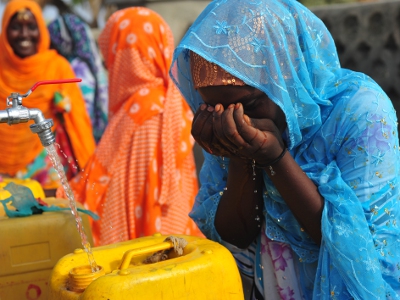Quenching the developing world’s thirst

A woman drinks from a public fountain at a village in Assab, Eritrea. Photo by: Jean-Paul Heerschap / EuropeAid
"Progress toward reaching the Millennium Development Goals on water and sanitation are off track. The United Nations itself has predicted: These targets will not be met by the internationally agreed-upon deadline in 2015.
Lack of progress in this area can be attributed to various factors, including poor policies and the low priority afforded water and sanitation projects compared with those in other areas of development. That’s not to say donors are not spending on efforts to improve the developing world’s access to clean drinking water and sanitation."
... and the article goes on.
According to OECD, Japan was the top spender on water and sanitation projects in 2010, the last year comprehensive data is available. It committed a total of $2.1 billion in bilateral aid and multilateral contributions to the sector. The next top spender was Germany ($1.1 billion), followed by France ($775.4 million). Other countries in the top 10 donors to the water and sanitation sector were the United States, Spain, the United Kingdom, the Netherlands, Italy, South Korea and Denmark.
The top country that received development assistance targeting water and sanitation issues in 2010 was Iraq. Following that were Vietnam, Bangladesh, India, Morocco, Sri Lanka, Egypt, Indonesia and Pakistan. Sub-Saharan African countries such as Kenya, Tanzania, Ghana, Ethiopia, Cameroon and Senegal also received significant amounts.
However, what struck me most was that this list does not match the list of countries with the highest number of people lacking access to water and sanitation. According to the United Nations, China is home to the most people lacking safe drinking water. China is followed by India, Nigeria, Ethiopia and Indonesia. and the Democratic Republic of the Congo, Bangladesh, Tanzania, Sudan and Kenya round out the top 10.
India, meanwhile, tops the list of places with the highest number of people without proper sanitation. Also on the list are China, Indonesia, Nigeria, Pakistan, Bangladesh, Ethiopia and the Democratic Republic of the Congo.
So why is it that WASH-related aid is not targeted to the most needy countries?
Not really a simple question to answer. Politics plays a big role. Governments provide aid to resource rich but economically poor counties (like South Sudan) in order to get those resources. Some governments won't give to countries if they support terrorists, no matter whether they've had the biggest earthquake in history.
Countries within your region are more likely to receive aid from your Government (take Australia as an example; a majority of its AusAid funding goes to Asia Pacific countries, although regions such as Africa and South Asia are receiving increasing amounts). And there are many other reasons that I don't know about or are too many to mention here.
But we should be using these figures related to the most WASH-needy countries to target our WASH aid. It just makes sense. How we do it ... save that discussion for another day.
The full link for this article is at:
http://www.devex.com/en/news/quenching-the-developing-world-s-thirst/79022?mkt_tok=3RkMMJWWfF9wsRojvKvLZKXonjHpfsX64ukoUae1lMI/0ER3fOvrPUfGjI4CSMdlI/qLAzICFpZo2FFcH/aQZA%3D%3D
No comments:
Post a Comment